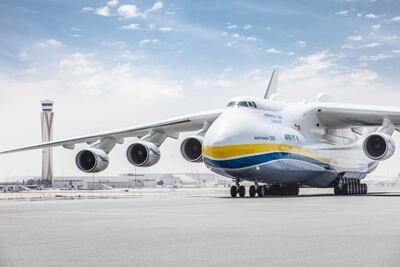As the world's larger commercial aircraft parked up around the world in recent months, the biggest, heaviest plane of all has been a regular sight in the sky.
The Ukrainian-built Antonov An-225 Mriya has always been an incredible spectacle, with its six engines, 32 wheels and wingspan that matches the length of a football pitch.
But its role in the aviation industry has taken on greater significance amid the coronavirus pandemic, as it delivers tonne after tonne of vital aid to countries worldwide.
Where has the Antonov been flying?
In the past week it has flown from Montreal in eastern Canada to Anchorage in the US state of Alaska before taking off for an 11-hour flight to Tianjin, China. Two days later it went on to Nagoya in Japan and then made the seven-hour passage back to Anchorage before, on the same day, flying six hours to Toronto where 25,000 boxes of medical supplies were unloaded.
Then on May 31 it flew back to Anchorage again.
In April, having been brought back into service after undergoing modernisation, the plane reportedly broke two world records for cargo shipments – first on April 14 when flying Tianjin to Warsaw in Poland with a total cargo of 1,000 cubic metres, and then a few days later when it transported 150 tonnes from China to France where it delivered masks, gloves and other protective clothing.
Is it cost effective given its size?
Nothing matches the AN-225 when it comes to handling outsize and exceptionally heavy payloads that once relied on ships to move them around the globe, Saj Ahmad, chief analyst at StrategicAero Research, told The National.
"In moving large supplies of emergency equipment, military needs and other machinery, the AN-225 is unbeatable," he said.
"It’s a pricey machine to use, but the offset of time saved by faster air transportation is second to none using this leviathan airplane. There’s little doubt that Antonov Airlines, which operates this beast, will be making a healthy sum of money each time this gargantuan airplane is called into action."
While the aircraft is playing an important role during the pandemic, Mr Ahmad believes it is unlikely more will be made given its infrequent use at other times. However, he does see a secure future for the plane.
"At a time when the Covid-19 pandemic has destroyed passenger air travel, cargo and shipments of goods by air is still critical for the global economy and having a weapon like the An-225 in your armoury is one that will generate some serious profitability," he said.
There's only one Antonov AN-225?
Yes, for now, although a second version was in the making and reached about 70 per cent completion in the mid-2000s before progress was halted because of the cost involved.
The Mriya (which means "dream" in Ukrainian) entered commercial service in 2001 and was originally developed to transport the Energiya carrier-rocket and Buran space shuttle.
Since its first flight in 1988, it has claimed 242 world records, according to Antonov Airlines. It is scheduled to continue flying until at least 2033.
It's statistics include a maximum payload of 250,000kg, a wingspan of 88m and total length of 84m. That means you can even slot a helicopter or haulage lorry inside.
The next biggest commercial airliner is the Boeing 747-8F, which handles up to 150 tonnes. Sandwiched between is the An-124, which can handle up to 150 tonnes but has a single deck, in contrast to the 747-8F which has both a main deck and lower cargo hold.
Has the AN-225 touched down in the UAE?
Indeed it has. In May 2016 the Mriya touched down at Al Maktoum International Airport after visiting Perth in Australia to deliver a 117-tonne generator.
It stopped in Dubai with no cargo on board and was on its way to Leonardo da Vinci–Fiumicino Airport in Rome.
Air cargo has been facing a capacity shortage during the pandemic
While this is true, UAE airlines have stepped up their efforts to ensure that supply lines have continued around the world.
The International Air Transport Association (Iata) warned in April of an "immediate and severe" shortage of global air cargo capacity. Idled passenger planes led to a nearly 44 per cent cut in the belly hold capacity that carried air cargo.
Abu Dhabi's Etihad Cargo boosted capacity to its top freighter gateways, as well as countries that were hit by travel restrictions.
Emirates meanwhile has been utilising Boeing 777 passenger aircraft for added cargo capacity, and shifted its operations to Dubai International Airport from Al Maktoum from April 1.
“As an extremely agile and customer-focused business, we have been able to establish a new network and schedule for our cargo operations within a short period of time, utilising lower deck capacity on our wide-body Boeing 777 passenger aircraft, which supplement the cargo capacity we offer on our freighter aircraft," said Nabil Sultan, Emirates divisional senior vice-president, cargo.
While Emirates has 115 Airbus A380s – the world's largest passenger aircraft – it isn't necessarily suited for cargo operations, Mr Ahmad, of StrategicAero, said.
"Due to the baggage needs for passengers, it holds very little cargo. And now that Covid-19 has decimated air travel, the A380 is not a jet that can be converted for freighter use since its internal structure is not designed to lift heavy payloads," he added.
What about the Airbus BelugaXL?
Another giant plane and shaped like a whale complete with smiley face, it entered service in January.
It is actually bigger than the Antonov in one respect: at 63m long and 8m wide, the it has the largest cargo bay cross-section of all existing cargo aircraft. It has a maximum payload of 51 tonnes, a range of 4,000km and flies between Airbus's 11 production sites in Europe to the company's assembly lines in France, Germany and China.



















